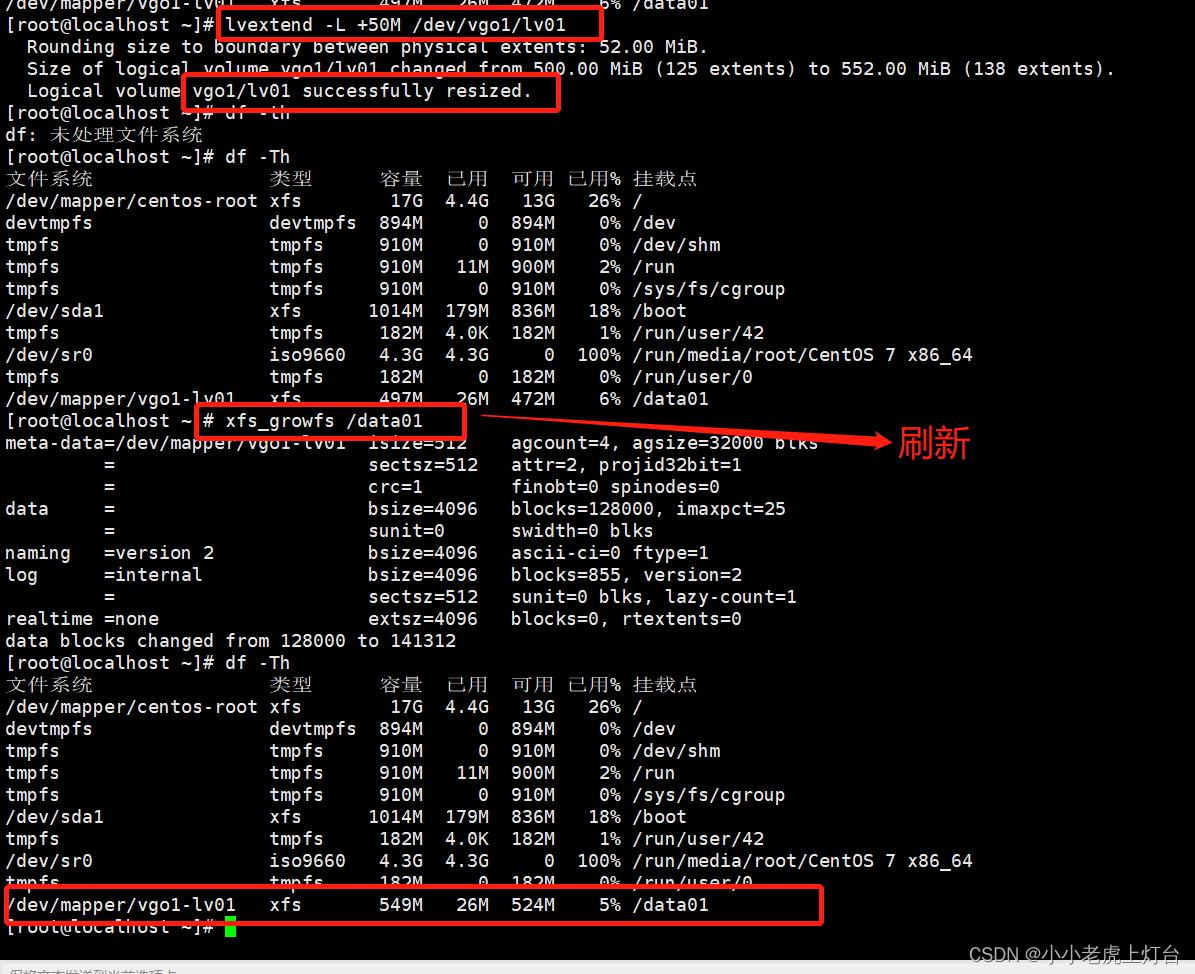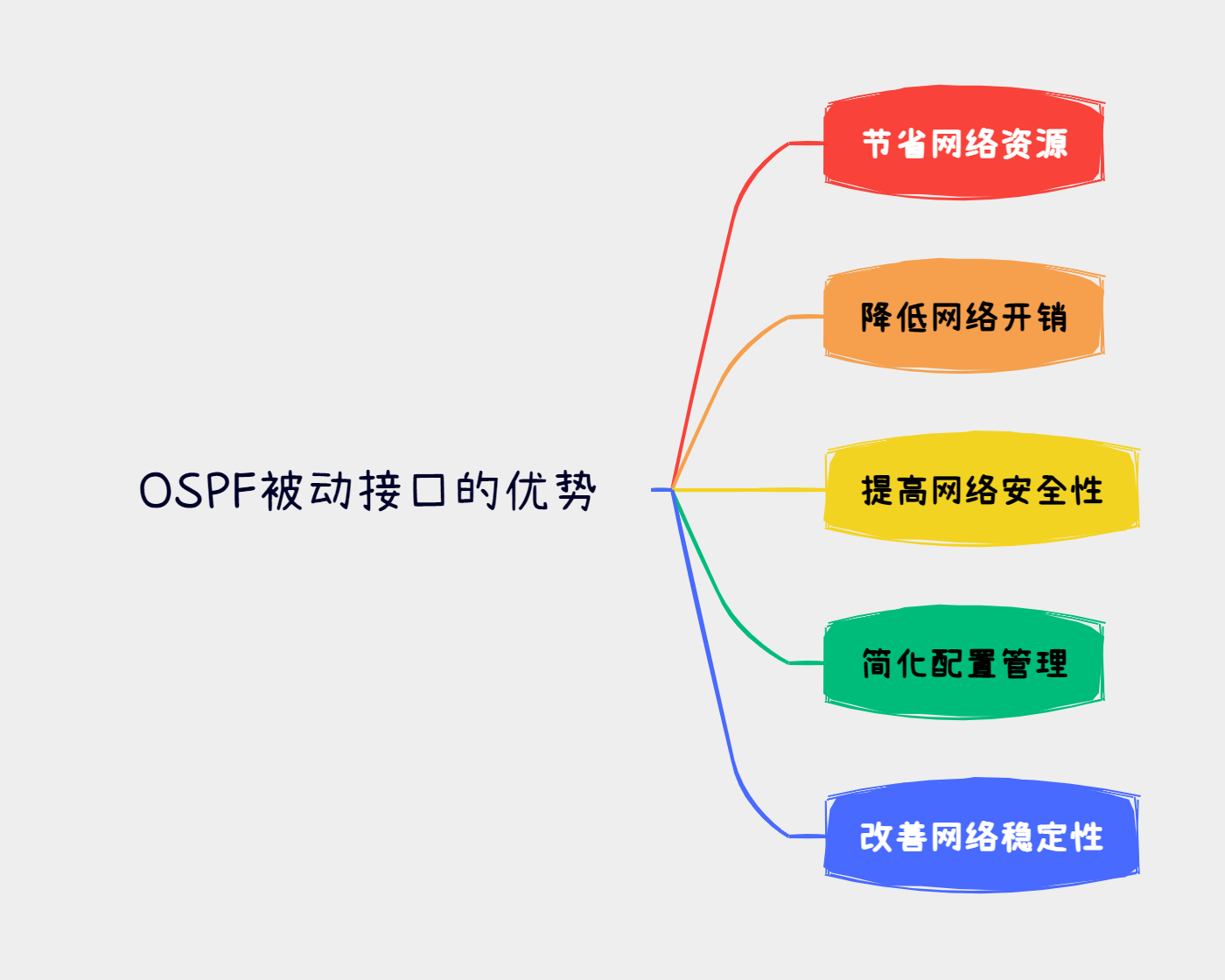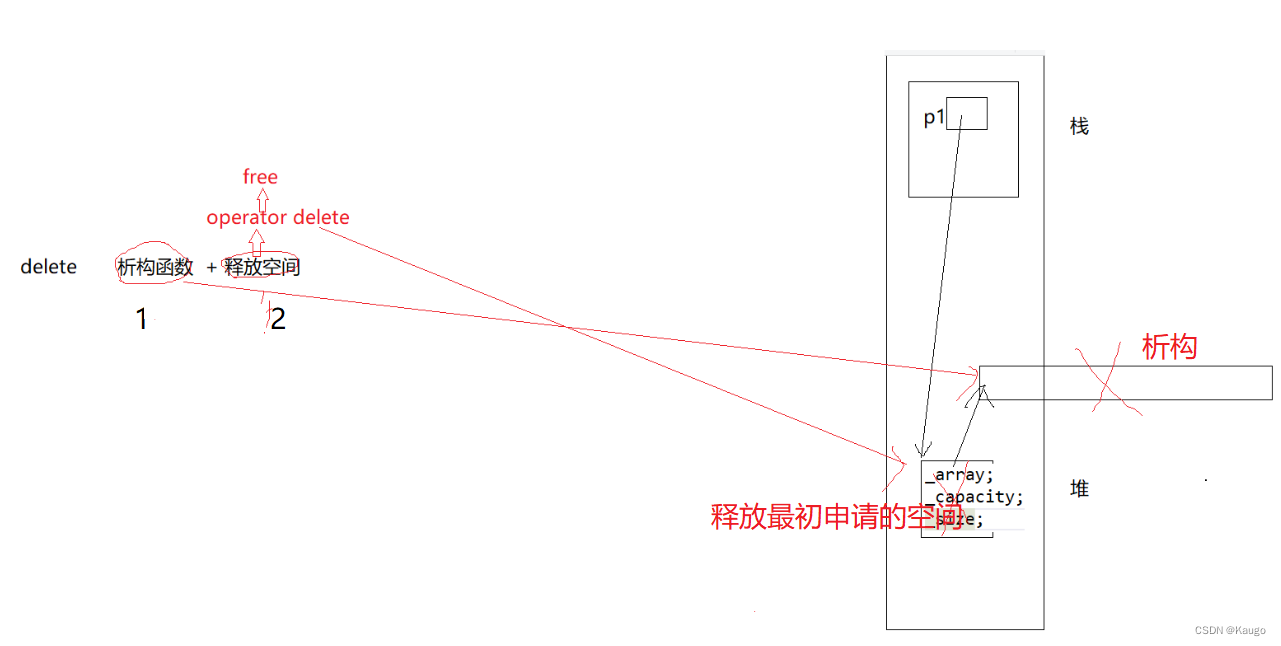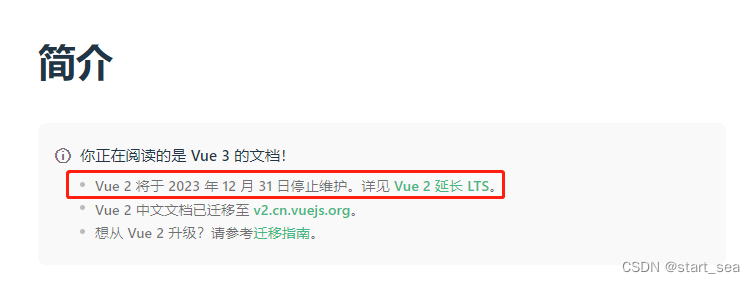本文代码基于Linux5.10
内容主要参考《Linux内核深度解析》余华兵
当Linux内核要创建一个新进程时, 流程大致如下
ret = fork();
if (ret == 0) {
/* 子进程装载程序 */
ret = execve(filename, argv, envp);
} else if (ret > 0) {
/* 父进程 */
}大致可以分为创建新进程和装载程序这两个过程。
创建新进程
Linux中创建新进程有两个系统调用, 分别是clone和fork, 其定义如下:
kernel/fork.c
SYSCALL_DEFINE0(fork) {
#ifdef CONFIG_MMU
struct kernel_clone_args args = {
.exit_signal = SIGCHLD,
};
return kernel_clone(&args);
#else
/* can not support in nommu mode */
return -EINVAL;
#endif
}
SYSCALL_DEFINE6(clone, unsigned long, clone_flags, unsigned long, newsp,
int, stack_size,
int __user *, parent_tidptr,
int __user *, child_tidptr,
unsigned long, tls) {
struct kernel_clone_args args = {
.flags = (lower_32_bits(clone_flags) & ~CSIGNAL),
.pidfd = parent_tidptr,
.child_tid = child_tidptr,
.parent_tid = parent_tidptr,
.exit_signal = (lower_32_bits(clone_flags) & CSIGNAL),
.stack = newsp,
.tls = tls,
};
return kernel_clone(&args);
}可以理解为fork是clone的简化版本, clone可以更精确的控制创建进程的行为,我们在创建线程时,就是使用的clone(没错, 在Linux里面, 线程实际上也是进程)。
clone 和 fork 都会调用kernel_clone 这个函数去创建进程,只不过两者传递的参数不同。
Linux 目前通过kernel_clone_args 这个数据结构来传递参数。
include/linux/sched/task.h
struct kernel_clone_args {
u64 flags;
int __user *pidfd;
int __user *child_tid;
int __user *parent_tid;
int exit_signal;
unsigned long stack;
unsigned long stack_size;
unsigned long tls;
pid_t *set_tid;
/* Number of elements in *set_tid */
size_t set_tid_size;
int cgroup;
struct cgroup *cgrp;
struct css_set *cset;
};flags : clone 标志。
stack : 只在创建线程时有意义, 用来指定线程的用户栈的地址
stack_size:只在创建线程时有意义, 用来指定线程的用户栈的大小
创建新进程的流程大致如下:
- 调用函数copy_process 创建新进程
- 调用函数wake_up_new_task 唤醒新进程。
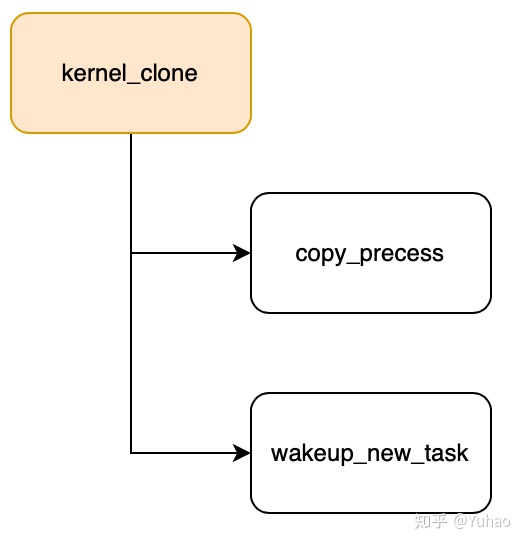
copy process
copy process的流程如下:

1.检查标志是否合法。
kernel/fork.c
/*
* Don't allow sharing the root directory with processes in a different
* namespace
*/
if ((clone_flags & (CLONE_NEWNS|CLONE_FS)) == (CLONE_NEWNS|CLONE_FS))
return ERR_PTR(-EINVAL);
if ((clone_flags & (CLONE_NEWUSER|CLONE_FS)) == (CLONE_NEWUSER|CLONE_FS))
return ERR_PTR(-EINVAL);
.....2.dup_task_struct。 已当前进程为模板, 创建task_struct数据结构
这里面会分配task_struct 的数据结构, 并分配内核栈。
内核栈也是一个slab。
kernel/fork.c
static unsigned long *alloc_thread_stack_node(struct task_struct *tsk,
int node)
{
unsigned long *stack;
stack = kmem_cache_alloc_node(thread_stack_cache, THREADINFO_GFP, node);
stack = kasan_reset_tag(stack);
tsk->stack = stack;
return stack;
}
void thread_stack_cache_init(void)
{
thread_stack_cache = kmem_cache_create_usercopy("thread_stack",
THREAD_SIZE, THREAD_SIZE, 0, 0,
THREAD_SIZE, NULL);
BUG_ON(thread_stack_cache == NULL);
}3.检查用户的进程数量限制
kernel/fork.c
if (atomic_read(&p->real_cred->user->processes) >=
task_rlimit(p, RLIMIT_NPROC)) {
if (p->real_cred->user != INIT_USER &&
!capable(CAP_SYS_RESOURCE) && !capable(CAP_SYS_ADMIN))
goto bad_fork_free;
}在用户空间, 可以通过ulimit -u 来设置用户最大可以创建的进程数量。
4.copy_creds
调用copy_cread 复制或者共享证书, 如果新进程和当前进程属于同一个线程组, 那么他们共享证书。
5. 检查线程数量限制
kernel/fork.c
if (data_race(nr_threads >= max_threads))
goto bad_fork_cleanup_count;nr_threads 会在每次创建进程/线程后+16.sched_fork
设置调度器相关的参数
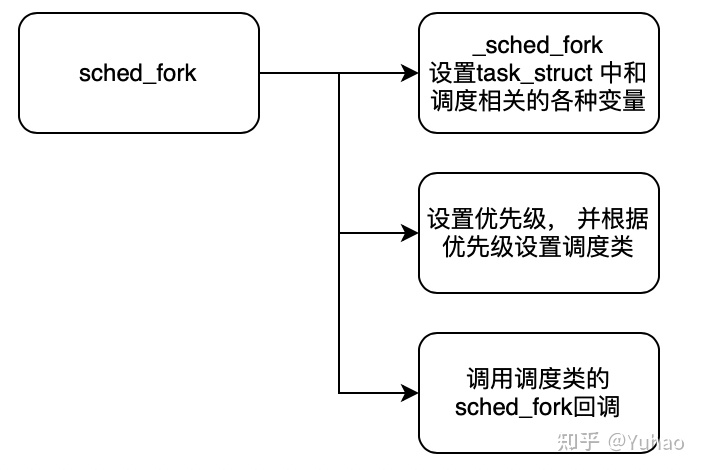
7.复制或者共享资源
这里会复制虚拟内存,文件, 文件系统数据, 信号处理数据等各种资源。 这里重点介绍一下copy_thread 这个流程, 这里会复制进程的各种寄存器。
arch/arm64/kernel/process.c
int copy_thread(unsigned long clone_flags, unsigned long stack_start,
unsigned long stk_sz, struct task_struct *p, unsigned long tls)
{
struct pt_regs *childregs = task_pt_regs(p);
memset(&p->thread.cpu_context, 0, sizeof(struct cpu_context)); /* 1 */
/*
* In case p was allocated the same task_struct pointer as some
* other recently-exited task, make sure p is disassociated from
* any cpu that may have run that now-exited task recently.
* Otherwise we could erroneously skip reloading the FPSIMD
* registers for p.
*/
fpsimd_flush_task_state(p);
ptrauth_thread_init_kernel(p);
if (likely(!(p->flags & PF_KTHREAD))) { /* 2 */
*childregs = *current_pt_regs();
childregs->regs[0] = 0; /* 3 */
/*
* Read the current TLS pointer from tpidr_el0 as it may be
* out-of-sync with the saved value.
*/
*task_user_tls(p) = read_sysreg(tpidr_el0);
if (stack_start) { /* 4 */
if (is_compat_thread(task_thread_info(p)))
childregs->compat_sp = stack_start;
else
childregs->sp = stack_start;
}
/*
* If a TLS pointer was passed to clone, use it for the new
* thread.
*/
if (clone_flags & CLONE_SETTLS)
p->thread.uw.tp_value = tls;
} else { /* 5 */
/*
* A kthread has no context to ERET to, so ensure any buggy
* ERET is treated as an illegal exception return.
*
* When a user task is created from a kthread, childregs will
* be initialized by start_thread() or start_compat_thread().
*/
memset(childregs, 0, sizeof(struct pt_regs));
childregs->pstate = PSR_MODE_EL1h | PSR_IL_BIT;
p->thread.cpu_context.x19 = stack_start;
p->thread.cpu_context.x20 = stk_sz;
}
p->thread.cpu_context.pc = (unsigned long)ret_from_fork; /* 6 */
p->thread.cpu_context.sp = (unsigned long)childregs;
ptrace_hw_copy_thread(p);
return 0;
}用户态相关的运行环境缓存在pt_regs 中, 内核态保存在thread结构体中。
(1) 获取pt_regs, 并初始化thread 结构体
(2) 对于用户进程的处理
(3) 设置返回值为0。(子进程fork返回0就是在这里设置)
(4) 设置线程的用户栈
(5) 对于内核进程的处理, 这里X19存储线程函数的地址,X20存放线程函数的参数
(6) 设置内核态的PC和SP值, 在发生进程切换时, 会切到原因的地方去
wake up new task
在新进程创建之后,会尝试去唤醒它,让它尽快得到执行, 其流程大致如下:

新进程第一次运行
前文说到,copy_thread是会把新进程的PC设置为ret_from_fork。
arch/arm64/kernel/entry.S
/*
* This is how we return from a fork.
*/
SYM_CODE_START(ret_from_fork)
bl schedule_tail
cbz x19, 1f // not a kernel thread
mov x0, x20
blr x19
1: get_current_task tsk
b ret_to_user
SYM_CODE_END(ret_from_fork)在ret_from_fork中, 首先进行调度切换的清理工作(schedule_tail)。 如果是用户进程,调用ret_to_user返回用户空间, 如果是内核进程,X19存储线程函数的地址,X20存放线程函数的参数, 这里会跳转到x19所存储的函数地址执行。
装载程序
一般来说, 用户层会调用execve或者execveat 执行某个具体的程序。
int execve(const char *filename, char *const argv[ ], char *const envp[ ]);用户程序一般是一个elf文件, 内核会按照elf文件的格式去解析它, 并设置PC到对应的entry。这部分内容不在此详细说明。
实例: init 进程的创建和运行
init 是kernel运行的第一个进程, 我们来看看它是怎么创建和运行起来。
在rest_init中,会调用kernel_thread 创建init进程
init/main.c
noinline void __ref rest_init(void)
{
.....
pid = kernel_thread(kernel_init, NULL, CLONE_FS);
.....
}
pid_t kernel_thread(int (*fn)(void *), void *arg, unsigned long flags)
{
struct kernel_clone_args args = {
.flags = ((lower_32_bits(flags) | CLONE_VM |
CLONE_UNTRACED) & ~CSIGNAL),
.exit_signal = (lower_32_bits(flags) & CSIGNAL),
.stack = (unsigned long)fn,
.stack_size = (unsigned long)arg,
};
return kernel_clone(&args);
}可以看到kernel_thread其实也是调用kernel_clone创建线程,其中stack被设置成了入口函数,stack_size被设置成了参数。
在kernel_init中, 会尝试装载init进程。
init/main.c
static int __ref kernel_init(void *unused)
{
.....
if (ramdisk_execute_command) {
ret = run_init_process(ramdisk_execute_command);
if (!ret)
return 0;
pr_err("Failed to execute %s (error %d)\n",
ramdisk_execute_command, ret);
}
....
}装载完成之后, 就会调转到用户态的init进程执行了。

![[IJCAI 2022] 基于个性化掩码的实用安全联合推荐](https://img-blog.csdnimg.cn/3a159b16f8ba495bb436b74fa2a3b364.png)


